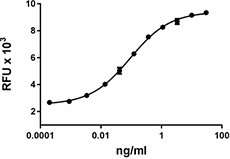- Regulatory Status
- RUO
- Other Names
- Interleukin-33, IL-33, Interleukin-1 Family, Member 11 (IL-1F11), Nuclear Factor From High Endothelial Venules (NF-HEV)

-

Rat IL-33 induces the proliferation of D10.G4.1 mouse cells.
| Cat # | Size | Price | Quantity Check Availability | ||
|---|---|---|---|---|---|
| 766402 | 10 µg | $206.00 | |||
| 766404 | 25 µg | $282.00 | |||
| 766406 | 100 µg | $710.00 | |||
Select size of product is eligible for a 40% discount! Promotion valid until December 31, 2024. Exclusions apply. To view full promotion terms and conditions or to contact your local BioLegend representative to receive a quote, visit our webpage.
IL-33 belongs to the IL-1 family and is closely related in structure to IL-18 and IL-1β. IL-33, IL-1β, and IL-18 are synthesized as biologically inactive precursor and are cleaved by the enzyme caspase-1 to be secreted as active mature forms. IL-33 stimulates target cells by binding to the IL-1R/TLR superfamily member ST2 and subsequently activates NF-κB and MAPK pathways via identical signaling events to those observed for IL-1b. In addition, IL-33 is a nuclear factor (NF-HEV) abundantly expressed in high endothelial venules from lymphoid organs that associates with chromatin and exhibits transcriptional regulatory properties. IL-33 plays a role in allergic disease, including allergic rhinitis and chronic rhinosinusitus and is elevated in humans and mouse models of atopic dermatitis.
Product Details
- Source
- Rat IL-33, amino acid Ser109-Met264 (Accession# NP_001014188) was expressed in E. coli.
- Molecular Mass
- The 156 amino acid recombinant protein has a predicted molecular mass of approximately 17.4 kD. The DTT-reduced and non-reduced protein migrates at approximately 20 kD respectively by SDS-PAGE. The predicted N-terminal amino acid is Ser.
- Purity
- >98%, as determined by Coomassie stained SDS-PAGE.
- Formulation
- 0.22 µm filtered protein solution is in PBS, pH 7.2.
- Endotoxin Level
- Less than 0.1 EU/µg of protein as determined by the LAL method.
- Concentration
- 10 and 25 µg sizes are bottled at 200 µg/mL. 100 µg size and larger sizes are lot-specific and bottled at the concentration indicated on the vial. To obtain lot-specific concentration and expiration, please enter the lot number in our Certificate of Analysis online tool.
- Storage & Handling
- Unopened vial can be stored between 2°C and 8°C for up to 2 weeks, at -20°C for up to six months, or at -70°C or colder until the expiration date. For maximum results, quick spin vial prior to opening. The protein can be aliquoted and stored at -20°C or colder. Stock solutions can also be prepared at 50 - 100 µg/mL in appropriate sterile buffer, carrier protein such as 0.2 - 1% BSA or HSA can be added when preparing the stock solution. Aliquots can be stored between 2°C and 8°C for up to one week and stored at -20°C or colder for up to 3 months. Avoid repeated freeze/thaw cycles.
- Activity
- ED50= 0.05 - 0.25 ng/ml, as determined by the dose dependent stimulation of D10.G4.1 cell proliferation.
- Application
-
Bioassay
- Application Notes
-
BioLegend carrier-free recombinant proteins provided in liquid format are shipped on blue-ice. Our comparison testing data indicates that when handled and stored as recommended, the liquid format has equal or better stability and shelf-life compared to commercially available lyophilized proteins after reconstitution. Our liquid proteins are verified in-house to maintain activity after shipping on blue ice and are backed by our 100% satisfaction guarantee. If you have any concerns, contact us at tech@biolegend.com.
- Product Citations
-
Antigen Details
- Distribution
-
Higher levels of rat IL-33 mRNA are detected in lung, kidney, uterus, liver and thymus. Expressed in endothelial and epithelial cells, spleen fibroblastic reticular cells, rat glioma cell.
- Function
- IL-33 drives production of Th2-associated cytokines from in vitro polarized Th2 cells. In mice, IL-33 injection induced the expression of IL-4, IL-5, and IL-13 and led to severe pathological changes in the lung and the digestive tract. IL-33 acts as a chemoattractant for Th2 cells, both in vitro and in vivo. TNF-α and IL-1β are activators of IL-33 transcription in fibroblasts and keratinocytes.
- Interaction
- Th2 cells, group 2 innate lymphoid cells (ILC2s), mast cells, subsets of Tregs, inflammatory cells, including NK cells, Th1 cells, and CD8+ T cells.
- Ligand/Receptor
- IL-33 binds to the receptor IL-1RL1 (ST2) and the coreceptor IL-1RAcP (IL-1 receptor associated protein).
- Bioactivity
- Rat IL-33 induces the proliferation of D10.G4.1 cells.
- Biology Area
- Immunology, Stem Cells
- Molecular Family
- Cytokines/Chemokines
- Antigen References
-
1. Schmitz J, et al. 2005. Immunity 23:479.
2. Barksby HE, et al. 2007. Clin. Exp. Immunol 149:217.
3. Arend WP, et al. 2008. Immunol. Rev 223:20.
4. Suzukawa M, et al. 2008. J. Immunol. 181:5981.
5. Moussio C, et al. 2008. PLoS One 3(10):e3331.
6. Fang KM, et al. 2014 Neuro Oncology 16:552.
7. Molofsky AB, et al. 2015 Immunity 42:1005. - Gene ID
- 361749 View all products for this Gene ID
- UniProt
- View information about IL-33 on UniProt.org
